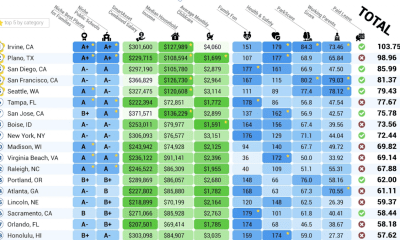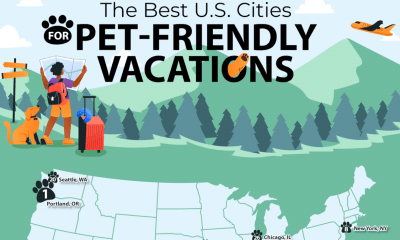Charts
America’s Birthday Patterns Reveal Demographics in New Chart
Have you ever noticed that certain months seem to have daily birthdays in your social circle? Kremp Florist’s new study shows birth patterns that reveal remarkable consistency in when people are born and interesting age variations across the states. Through analysis of data from 29.8 million births recorded from the CDC WONDER Natality database and nearly 16 million census survey responses, the data unveils hidden demographic patterns that shape everything from our family planning to regional economics.
Click here to zoom.
The standout finding is in the most popular birth month. August is by far the most common birth month in 45 out of 50 states. This consistency reflects a few factors that we can tie to conception periods. Late fall to early winter is an ideal time to start a pregnancy. Counting nine months back from August indicates a conception period in November to December. Chill outdoor temperatures encourage more intimate indoor time, and festive dates like Thanksgiving, Christmas, and New Year’s provide opportunities for relaxation and celebration. The positive mood can foster romantic connections.
Science also supports this pattern, suggesting that sperm quality peaks during the winter months and declines in the summer heat since sperm prefer a cooler environment, and high temperatures reduce the quantity and mobility of sperm. Female fertility is affected by the seasons, too. Shorter fall and winter days boost melatonin production, which supports the circadian rhythms that stabilize fertility hormones like prolactin.
The data also goes so far as to reveal the most common single birthday in America. While August dominates the monthly birthday rate, the most common individual birthday is September 9th. There have been about 12,301 birthdays celebrated annually on that day for the past 20 years. This specific birthday is a shared experience for many people, including celebrities like Adam Sandler, Otis Redding, Michael Bublé, Hugh Grant, Leo Tolstoy, and Colonel Sanders.
The team’s analysis also shows us state-by-state age demographics that reflect economic opportunities, migration patterns, and other cultural factors. Maine is the oldest state in America, with a median age of 55. Populations there are living longer, and birth rates are on the decline. Utah has the youngest population, with an average age of 37. The youthful makeup of Utah stems from the state’s high birth rates and youthful urban population.
We generally see older populations in northeastern states like Vermont, New Hampshire, and Delaware. Western and mountain states skew younger, like in Idaho, Texas, and Colorado. These demographics are influenced by economic development, healthcare demands, educational opportunities, and other factors that influence migration to and from the state and longevity.
Kremp’s graphic shows some fascinating regional patterns and consistency trends in ages and birth timing. All these factors help shape America’s diverse landscape and unique regional identities.
Charts
Study Examines the Best Cities for Raising Kids
Many American families realize that location can have a major impact on their childhood experiences. The team at HireAHelper examines which U.S. cities offer the best environment for families. Their recently published map ranks cities based on their scores in a 10-factor “Family-Friendly Cities Index.” They not only reveal which cities earned the highest scores but also help us consider the factors families should weigh when deciding where to move.
Click below to zoom.
HireAHelper’s scoring index considers ten important dimensions that shape the way a city serves families and makes it an ideal place to raise children. Here are the index factors:
- Public school quality: The strength of the city’s public schools based on scores from the website, Niche.
- Overall “family-friendliness” rating: Niche’s city score based on safety, walkability, access to services, amenities, and livability.
- Cost of living: An estimate of the household income needed for a family to live comfortably.
- Childcare costs: This figure is based on how much it costs on average to send a newborn and a 4-year-old to daycare.
- Median household income: This shows the average household income in this location.
- Family fun: The availability of playgrounds, entertainment, parks, and kid-friendly activities.
- Health and safety: This considers crime rates, number of pediatricians, and general environmental health and well-being.
- Park quality: Based on the Trust for Public Land’s 2025 score on the acreage, amenities, accessibility, and investment in parks.
- Working Parents Score: This considers job flexibility, co-working availability, and remote-work friendliness.
- Family leave benefits: Not every state offers paid family leave, but it’s a huge advantage for parents during early childhood years.
The top-ranked city according to the team’s extensive analysis is Irvine, California. Irvine’s A+ rating in Niche’s public education category and its overall family-friendly score put it at the top of the list. Irvine has a higher cost of living and childcare costs than other cities on the list, but a high average household income helped offset those expenses. The city also scored well in safety, park quality, and family-fun. Families who can afford it will find a strong city that offers everything they could wish for: amenities, strong schools, and a high quality of life.
The strength of the team’s study lies in the details. Moving is never a one-size-fits-all endeavor. Different families will have other priorities and values, whether they relate to the importance of education, safety, affordability, or work flexibility. This study’s approach helps families consider a range of factors and rank cities based on their own needs. After all, a higher cost of living might be out of reach for some families, but affordability means compromise elsewhere, and families will have to choose whether they want this to be in the realm of family fun, parks, or some other area.
This study gives families a data-driven way to start their search for a new city to relocate to. Not every family will agree that Irvine, California, is the best option, but they will find many other options on the list, each with their own attractions.
Charts
Study Examines Where Renters Can and Cannot Afford to Buy Their Homes
Home ownership is a dream shared by many Americans, but the goal posts for achieving this dream move further out of reach every year. In 2025, the average age for first-time home ownership reached an all-time high of 40 years old. That’s an 8-year increase from just 5 years previous. The biggest obstacle to home ownership is the high price tag. Housing prices have risen by an astonishing 2,000% over the past 60 years. While these statistics might make home ownership seem impossible, the team at MovingPlace.com shows that location is a huge factor in affordability. The team analyzed which ZIP codes have renters who could afford to buy a home. They mapped the results, showing where home ownership is most achievable and where it is flat-out impossible.
Click below to zoom.
To form their calculations, the team analyzed these factors:
- Median Home Value
- Mortgage Rate
- Monthly Mortgage Payment
- Renter Income
- Monthly Renter Income
- Mortgage-to-Income Ratio
- Average Cost of Rent
- Rent-to-Income Ratio
The results show us that these are the ZIP codes where renters can afford to buy their own home:
- 30349: Atlanta, GA
- 75217: Dallas, TX
- 60617: Chicago, IL
- 37042: Clarkesville, TN
- 60629: Chicago, IL
- 73099: Yukon, OK
- 60623: Chicago, IL
- 78577: Pharr, TX
- 27610: Raleigh, NC
- 28269: Charlotte, NC
The ZIP code with the lowest mortgage-to-income ratio is in Fulton County, Georgia. There are 15 cities in this county, including Atlanta, one of the largest American cities. The result comes as no surprise since Atlanta is one of the most affordable major cities in the country.
On the other end of the spectrum, there are many ZIP codes where homes are so expensive that renters can’t hope to buy in these locations. Here are the ZIP codes with the most prohibitive ratios:
- 11204: Brooklyn, NY
- 10453: Bronx, NY
- 98052: Redmond, WA
- 10025: New York, NY
- 11385: Ridgewood, NY
- 98012: Bothell, WA
- 91709: Chino Hills, CA
- 10314: Staten Island, NY
- 60647: Chicago, IL
- 90250: Hawthorne, CA
Brooklyn has the least affordable American ZIP code. Average renter incomes simply don’t compare with the median home price in Brooklyn, which is $1,198,458. This could pay for five homes in Fulton County, Georgia.
Overall, the team followed a 28/36 ratio rule. The mortgage-to-income ratio had to be below 28% to be considered affordable. We can also see that different areas of a city can differ drastically in home prices. For example, two ZIP codes within the city of Chicago in Cook County are on the most affordable list, while another ZIP code is on the least affordable list. This is nothing new in real estate. Some neighborhoods are more highly sought after than others, and competition drives up prices to shocking heights.
While home ownership is no doubt a challenge, this map shows that there are many places in the U.S. where it’s possible for renters to start house shopping. Location is one of the biggest factors in making the dream of homeownership a reality.c
Charts
Ranking the Best U.S. Cities for Pet-Friendly Vacations
Many Americans are devoted to their pets and consider their furry friends a part of the family. That means they want to include them in travel plans and vacations. A pet sitter or pet boarding can be pricey, plus pet parents will miss their pet companions while they’re away. The team at FloridaRentals.com created a valuable map for traveling pet owners, ranking U.S. cities by pet friendliness.
Click below to zoom.
The team considered several crucial factors when creating the ranking’s scoring system. Here are the factors considered:
- Percentage of pet-friendly hotels
- Average price of pet-friendly hotels
- Number of dog-friendly restaurants
- Dog park quality score
- Best cities to walk your dog score
- Pet health score
- Average review score of pet-friendly hotels
- Number of dog-friendly activities
- Dog parks per 100,000 residents
- Dog climate score
- Number of 24-hour vets
- WalletHub’s most pet-friendly cities score
All of these factors combine to help pet owners decide whether a city offers what they need. Many pet owners feel that the number, quality, and cost of pet-friendly hotels and restaurants are the most important factors. In contrast, others want to know they can have fun with their dog while vacationing with decent weather and plenty of walking trails and parks to explore. Others might put safety first and consider the presence of plenty of vet clinics to be most important.
After all scores were considered, a handful of cities rose above the others with the highest scores in the nation. Here are the ten cities with the highest scores:
- Portland, Oregon
- Albuquerque, New Mexico
- Phoenix, Arizona
- San Francisco, California
- Tampa, Florida
- San Diego, California
- Austin, Texas
- New York, New York
- Tucson, Arizona
- Colorado Springs, Colorado
Portland earned the top spot with high scores in nearly every category. The city has an abundance of beautiful parks and walking trails, paired with a strong pet-friendly culture. Albuquerque and Phoenix earned their high ranking thanks to plenty of affordable pet-friendly hotels and restaurants, paired with ample outdoor space. San Francisco, Tampa, and San Diego are great destinations for travelers seeking warm weather, walkable cities, and plenty of restaurants that welcome pets. In fact, many cities in Florida scored well, likely due to the warm climate and tourist-heavy culture.
We can see that cold-weather cities scored lower, like Boston, Milwaukee, and Detroit. Though accommodation prices are higher there and there may be fewer dog parks, there are still plenty of dog-friendly activities to enjoy in these bustling cities, especially if you don’t mind the cold.
Overall, this map shows that pet-friendly travel is not only possible but also a lot of fun, with many options for destinations. A great pet-friendly stay will combine affordability with comfort, safety, and fun for both you and your furry friend. As pet travel booms, these cities might even expand the accommodation they already offer.
-
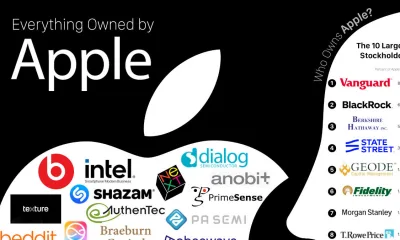
 Business Visualizations1 year ago
Business Visualizations1 year agoEverything Owned by Apple
-
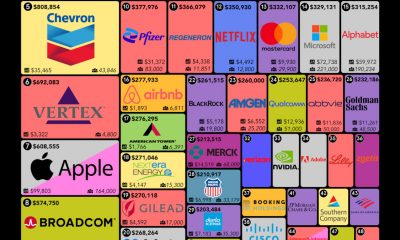
 Business Visualizations1 year ago
Business Visualizations1 year agoAmerica’s Most Valuable Companies Ranked by Profit per Employee
-
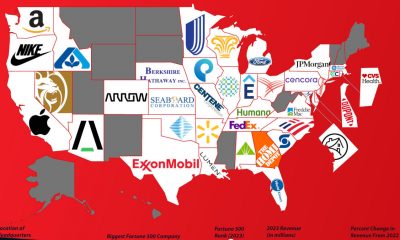
 Business Visualizations10 months ago
Business Visualizations10 months agoThe Biggest Fortune 500 Company in Every State
-
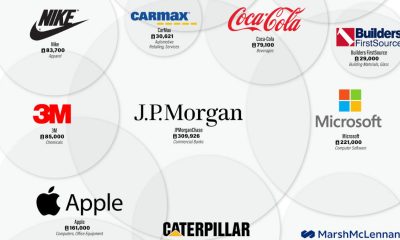
 Business Visualizations7 months ago
Business Visualizations7 months agoThe Biggest Employers by Industry
-

 Maps2 years ago
Maps2 years agoPenis Lengths Around the World
-
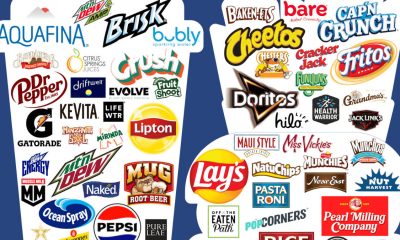
 Business Visualizations2 years ago
Business Visualizations2 years agoAll The Brands Owned By PepsiCo
-
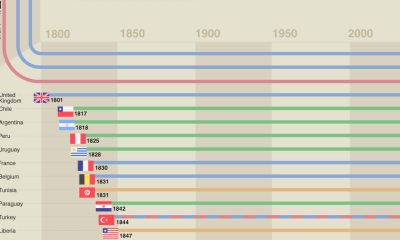
 Timelines2 years ago
Timelines2 years agoA History of the Oldest Flags in the World
-
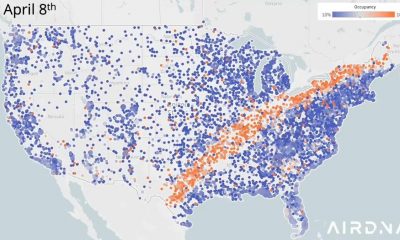
 Business Visualizations2 years ago
Business Visualizations2 years agoNew Animated Map Shows Airbnb’s Fully Booked Cities Along the 2024 Eclipse Path of Totality


